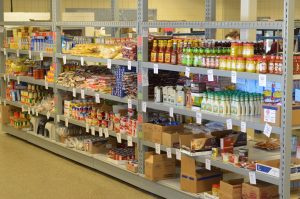Be mindful of donating safe and healthy foods to pantries
University of Illinois Extension Services — December 7, 2018
Holiday season brings on food drives and people’s wishes to donate to food pantries. Nutritionists remind us to pay close attention to the best “used by” dates on nonperishable items and to be mindful of donating foods with a higher nutritional value. (Photo courtesy of U of Wisconsin)
As we move towards the holidays, food pantries are looking to fill their shelves. Giving to a food drive is an easy way to give back to your community. There are a few key tips to consider when donating to a food drive.
“The number one rule of donating food,” according to Carol Erickson, SNAP Ed Educator for University of Illinois Extension, “only donate the food you would serve your family. It is tempting to clean out the pantry and donate food that has been in there for a while. No matter what your income is, everyone wants safe and healthy food.”
Erickson recommends taking a closer look at the food that you give away. Shelf stable foods like cereal, mixes, peanut butter, and canned fruits and vegetables have dates that warn the consumer when they are best “used by.”
These foods are still safe after the date but the quality and flavor decreases. Only donate food that is within a close proximity of the “used by” dates. The exception to this rule is baby formula. It is not safe to donate baby formula that has exceeded this by date.
Expiration dates are put on baking ingredients like yeast, baking powder, and cake mixes. Again, this is not a safety issue but a quality issue. Do not donate foods that are past their expiration date.
Another food safety term that is often used is “sell by” or pull dates. They are used on perishable items like milk and cheese — foods not appropriate for a food drive.
Even if your food is within safe dates, take a close look at the packaging. If a box is damaged or open, please throw it away. Do the same with dented or rusty cans. After major food drives, food pantries spend time and money to dispose of damaged and contaminated food. Remember the rule – if you won’t eat it, don’t give it away!
Individuals and families who seek assistance for food want healthy options. More food pantries are trying to offer foods with reduced sugar and salt for individuals with special dietary needs. If you have family members who have special dietary needs, consider purchasing additional food items that you can donate.
As you consider what food to donate, think about the different food groups represented in MyPlate: fruit, vegetables, grains, protein, and dairy. Here are some healthy options for each food group:
Fruit: unsweetened applesauce, canned fruit in water/light syrup/100 percent juice, dried fruit, fruit pouches, and 100 percent fruit juice.
Vegetables: 100 percent vegetable juice, low-sodium canned soups, no-added/low/reduced sodium canned vegetables and spaghetti sauce, dried or dehydrated vegetables.
Grains: cereal and oatmeal with 3 grams of fiber, whole grain bread, pasta, and tortillas, barley, cornmeal, brown and instant rice, whole grain crackers, whole grain flour, corn tortillas.
Protein: low-sodium canned beans, dried beans/peas/lentils, unsalted or lightly nuts, canned tuna/salmon/chicken in water, nut butters like peanut, almond, or cashew with less than 230 mg sodium and 4 grams of sugar/serving.
Dairy: shelf-stable milk, soy/almond/rice milk, powdered milk, baby formula.
With increasing expenses during the holidays, individuals and families who seek food assistance are appreciative of the food they receive at local food pantries. Your healthy and safe food donations can make a difference for some of your neighbors this season.
As you select food to donate, remember only give food that you would put on the table for your family.



